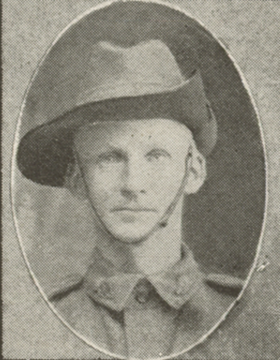
FORSYTH, Norman Alexander
| Service Number: | 2945 |
|---|---|
| Enlisted: | 19 October 1916, Brisbane, Queensland |
| Last Rank: | Private |
| Last Unit: | 41st Infantry Battalion |
| Born: | Flinders, Queensland, Australia, 3 December 1883 |
| Home Town: | Moore, Somerset, Queensland |
| Schooling: | Not yet discovered |
| Occupation: | Sawyer/Farmer |
| Died: | Died of wounds, France, 2 April 1918, aged 34 years |
| Cemetery: |
Doullens Communal Cemetery Extension No.1, France |
| Memorials: | Australian War Memorial Roll of Honour, Brisbane 41st Battalion Roll of Honour, Esk Presbyterian Church Roll of Honour, Esk War Memorial, Moore WW1 Roll of Honour |
World War 1 Service
| 19 Oct 1916: | Enlisted AIF WW1, Private, 2945, Brisbane, Queensland | |
|---|---|---|
| 23 Dec 1916: | Involvement Private, 2945, 41st Infantry Battalion, --- :embarkation_roll: roll_number: '18' embarkation_place: Sydney embarkation_ship: HMAT Demosthenes embarkation_ship_number: A64 public_note: '' | |
| 23 Dec 1916: | Embarked Private, 2945, 41st Infantry Battalion, HMAT Demosthenes, Sydney |
Narrative
Norman Alexander FORSYTH #2945 41st Battalion
Norman Forsyth was born at Flinders View south of Ipswich, the son of William and Martha Forsyth. He attended school at Flinders View but the family had moved to Moore by the time that Norman enlisted.
When Norman attended the Brisbane recruiting depot on 19th October 1916 he was 33 years old. He had previously attempted to enlist but was rejected because of bad teeth. He probably solved that problem, as was common practice at the time, by having all his teeth removed and having full dental plates fitted. Norman stated his occupation as sawyer and his address as Moore, Brisbane Valley Line.
Norman was placed into a depot battalion before being allocated as a reinforcement for the 41st Battalion. A period of home leave in November preceded a relocation to Sydney where the recruits boarded the ‘Demosthenes’ on 23rd December 1916. The transport ship had to take the long route to England via Capetown and Sierra Leone due to a threat of enemy submarines in the Mediterranean. Norman and his mates came ashore in Plymouth on 3rd March 1917. After some time in a training camp at Larkhill, Norman finally was taken on strength by the 41st Battalion at Messines on 18th July 1917.
The first major engagement for the 41st in the Flanders campaign was at Broodseinde Ridge on 4th October where Norman sustained a shrapnel wound to his thigh. By 10th October, Norman was in hospital in England. After discharge from hospital he was posted to a convalescent depot at Dartford. Norman enjoyed a 14 day furlough over November/ December before reporting back to Dartford. He was passed fit and in the first week in January 1918, Norman began the journey back to his battalion.
The winter of 1917/18 had been a restful time for the Australian divisions that were in the rear areas around Poperinghe in Belgium. With the coming of spring, the British commanders were aware that a small window of opportunity presented itself to the German commander Ludendorff as he had at his disposal a large number of troops that could be redirected from the eastern front once the armistice was signed with Lenin’s Bolshevik government.
Operation Michael began with a full scale attack directed along the line of the Somme River across battlefields that had been won at such great cost by the British forces in 1916 and 1917. Within a week, the German forces had progressed as far as the confluence of the Somme and Ancre Rivers, and within striking distance of the city of Amiens. The British 5th Army, which had been holding the line in this sector, broke and retreated in disarray. To halt the advance, the British Commander Douglas Haig ordered as many brigades of Australians as possible to be rushed south in double decker buses to stem the German advance.
The 41st was one of the first battalions of the 11th Brigade AIF to reach the battlefield and by the 28th March had taken up positions at Sailley Le Sec between the Ancre and the Somme. The Germans launched an attack on the night of the 29th/30th March against the hastily prepared positions. Norman Forsyth was hit in the side and chest by machine gun fire while moving up to a post in no man’s land on 30th. Stretcher bearers dressed his wounds and took him to a Field Ambulance and from there to a Casualty Clearing Station. Norman was eventually admitted to the 3rd Canadian Stationary Hospital at Doullens where he succumbed to his wounds on 2nd April. Norman was buried in the Doullens Communal cemetery with Rev, Wilkinson in attendance.
A parcel of personal effects was despatched to Norman’s father in Moore from the AIF Kit Store per the S.S. Barunga. Unfortunately the Barunga, a former German freighter seized by Australian authorities in Sydney in 1914, was torpedoed by a U-Boat off the Scilly Isles. No lives were lost but all 5000 items containing personal effects of deceased servicemen were lost.
Submitted 14 February 2022 by Ian Lang











